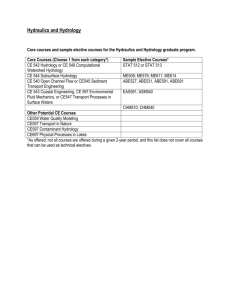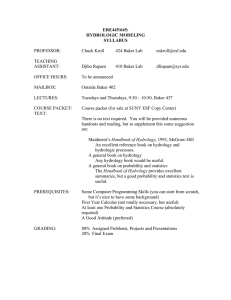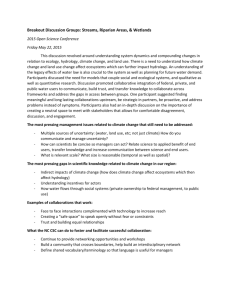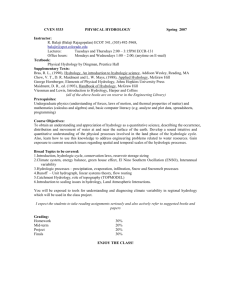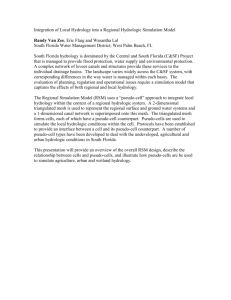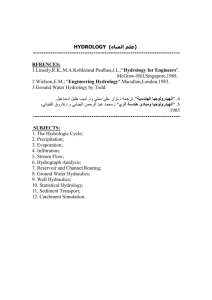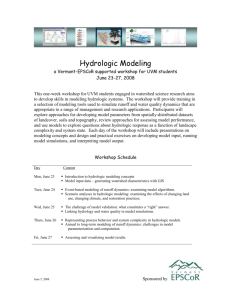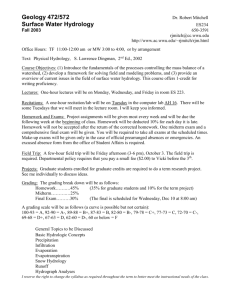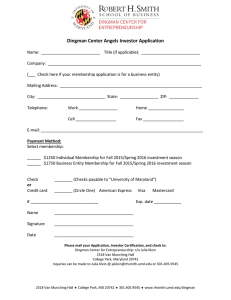Course Form
advertisement
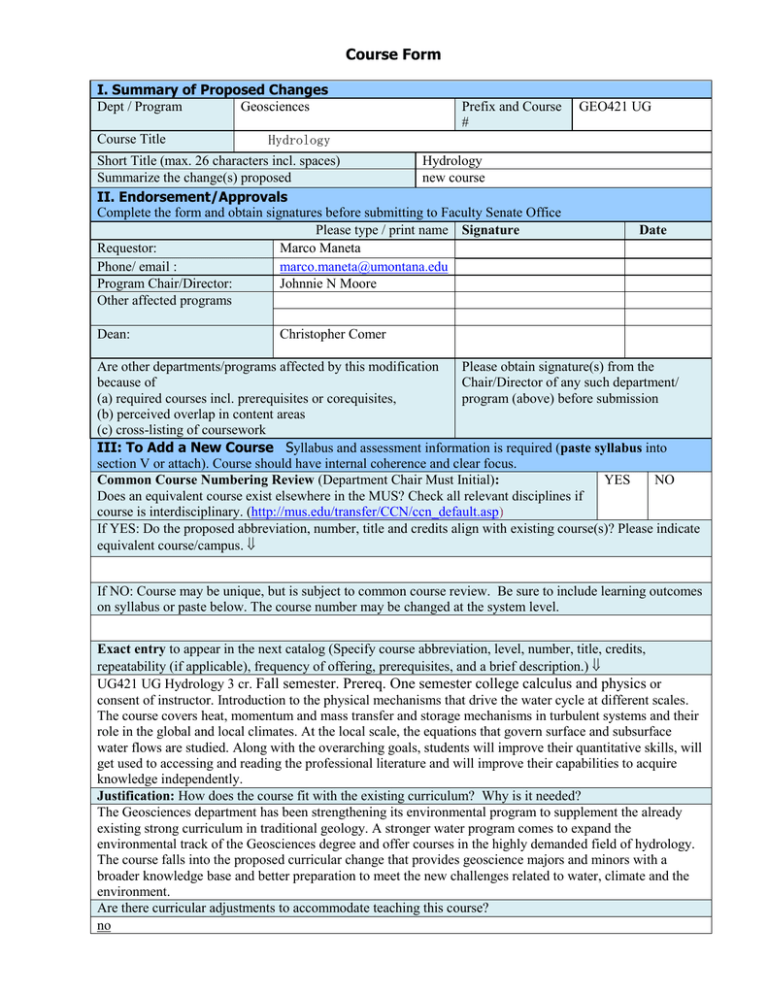
Course Form I. Summary of Proposed Changes Dept / Program Geosciences Prefix and Course # Hydrology Short Title (max. 26 characters incl. spaces) Hydrology Summarize the change(s) proposed new course II. Endorsement/Approvals Complete the form and obtain signatures before submitting to Faculty Senate Office Please type / print name Signature Requestor: Marco Maneta Phone/ email : marco.maneta@umontana.edu Program Chair/Director: Johnnie N Moore Other affected programs GEO421 UG Course Title Dean: Date Christopher Comer Are other departments/programs affected by this modification Please obtain signature(s) from the because of Chair/Director of any such department/ (a) required courses incl. prerequisites or corequisites, program (above) before submission (b) perceived overlap in content areas (c) cross-listing of coursework III: To Add a New Course Syllabus and assessment information is required (paste syllabus into section V or attach). Course should have internal coherence and clear focus. Common Course Numbering Review (Department Chair Must Initial): YES NO Does an equivalent course exist elsewhere in the MUS? Check all relevant disciplines if course is interdisciplinary. (http://mus.edu/transfer/CCN/ccn_default.asp) If YES: Do the proposed abbreviation, number, title and credits align with existing course(s)? Please indicate equivalent course/campus. If NO: Course may be unique, but is subject to common course review. Be sure to include learning outcomes on syllabus or paste below. The course number may be changed at the system level. Exact entry to appear in the next catalog (Specify course abbreviation, level, number, title, credits, repeatability (if applicable), frequency of offering, prerequisites, and a brief description.) UG421 UG Hydrology 3 cr. Fall semester. Prereq. One semester college calculus and physics or consent of instructor. Introduction to the physical mechanisms that drive the water cycle at different scales. The course covers heat, momentum and mass transfer and storage mechanisms in turbulent systems and their role in the global and local climates. At the local scale, the equations that govern surface and subsurface water flows are studied. Along with the overarching goals, students will improve their quantitative skills, will get used to accessing and reading the professional literature and will improve their capabilities to acquire knowledge independently. Justification: How does the course fit with the existing curriculum? Why is it needed? The Geosciences department has been strengthening its environmental program to supplement the already existing strong curriculum in traditional geology. A stronger water program comes to expand the environmental track of the Geosciences degree and offer courses in the highly demanded field of hydrology. The course falls into the proposed curricular change that provides geoscience majors and minors with a broader knowledge base and better preparation to meet the new challenges related to water, climate and the environment. Are there curricular adjustments to accommodate teaching this course? no Complete for UG courses. (UG courses should be assigned a 400 number). Describe graduate increment (http://umt.edu/facultysenate/committees/grad_council/procedures/gradIncrement.aspx) To obtain credit, graduates students will complete assignment 4 (for graduates only) where they will learn and use advanced methods to find the solution of the non-linear energy equations used to compute the dynamics of surface temperatures in a watershed. In addition, they will be requested to moderate and lead the discussion on the assigned readings on hillslope hydrology that are handed at the end of the semester. Graduates students are also expected to discuss the results found during regular assignments in more detail and with a higher level of sophistication than undergraduate students. New fees and changes to existing fees are only approved once each biennium by the Board of Regents. The coordination of fee submission is administered by Administration and Finance. Fees may be requested only for courses meeting specific conditions according to Policy 940.12.1 http://mus.edu/borpol/bor900/940-12-1.pdf . Please indicate whether this course will be considered for a fee. If YES, what is the proposed amount of the fee? Justification: IV. To Delete or Change an Existing Course – check X all that apply Deletion Title Course Number Change From: Level U, UG, G To: Description Change Change in Credits From: To: Prerequisites 1. Current course information at it appears in catalog (http://www.umt.edu/catalog) YES NO X From: To: Repeatability Cross Listing (primary program initiates form) Is there a fee associated with the course? 2. Full and exact entry (as proposed) 3. If cross-listed course: secondary program & course number 4. Is this a course with MUS Common Course Numbering? http://mus.edu/transfer/CCN/ccn_default.asp If yes, please explain below whether this change will eliminate the course’s common course status. YES NO 5. Graduate increment if level of course is changed to UG. Have you reviewed the graduate Reference guidelines at: increment guidelines? Please check (X) space provided. http://umt.edu/facultysenate/committees /grad_council/procedures/gradIncrement.aspx (syllabus required in section V) 6. Other programs affected by the change 7. Justification for proposed change V. Syllabus/Assessment Information Required for new courses and course change from U to UG. Paste syllabus in field below or attach and send digital copy with form. GEO421: Hydrology University of Montana Instructor: Marco Maneta Email: marco.maneta@umontana.edu Office: CHCB 316 Phone: 406-243-2454 Class meetings: Monday-Wednesday-Friday 11:10-12 Overarching goals: In this course students will develop the skills to Evaluate how disturbances (either natural or anthropogenic) on any component of the hydrologic cycle at the global or watershed scale will propagate in the system. Apply technical knowledge to quantify the flux and storage of water and energy in the different components of the hydrologic cycle. Design an experimental setup to investigate hydrologic processes. Ancillary goals: Along with the overarching goals, in this course students will improve their quantitative skills, will get used to accessing and reading the professional literature and will improve their capabilities to acquire knowledge independently. Prerequisites: Although this year the course is listed with no formal prerequisites, some background in calculus (equivalent to one semester) and basic physics (Newton’s laws) is expected. The students will find extensive use of derivatives and integrals in the readings along with different forms of the momentum equation. Also some computer literacy and knowledge of spreadsheets is expected, since some of the exercises will involve using MS-Excel. Dynamics of the course: I am expecting that you keep up-to-date with the readings. At the beginning of each unit the key points of the topic will be explained and in subsequent lectures we will visit the core parts that may need to be reinforced with further explanation but I am not planning to rephrase the textbook. The bulk of the unit will consist of class activities/exercises and examples where you can apply newly acquired technical knowledge and develop analytical and quantitative skills. In the activities we will detect which parts are not well understood and will have the chance to work on them. You should bring a scientific calculator to class. Office hours: Monday and Wednesday 2:10-3:00pm. The class schedule and class activities in this syllabus are tentative and are subject to change. Grades: 40% class activities – 20% report on readings - 40% exams. Text book: S L Dingman (2002). Physical Hydrology (2nd edition). Waveland Press. Long Grove, Illinois Class activities/assignments: Class activity 1: Watershed delineation and mass balance model at the watershed scale. Class activity 2: Energy balance for the Earth. Class activity 3: Snowmelt model. Class activity 4: Energy balance at the watershed scale. Class activity 5: Calculate water depth for a given discharge in a channel using Manning’s eq and N-R. Class activity 6: Classic hydrology models at the watershed scale. Class activity 7: Observation network design. Report on papers: Along with the seven assignments, in the second half of the course the students will be asked to read a set of key paradigm-changing research papers in the field of hydrology. These papers outline the modern history of hydrology and are good examples of how science advances by posing relevant testable hypotheses, performing breakthrough experiments that support them and incorporating this new knowledge into improved working models. In the last unit of the course students will have to present (1 paper per student) what was the state-ofthe-art in hydrology at the time, the hypothesis raised by the researchers and why they raised it, how they designed the experiment to test the hypotheses, what the outcome of the experiment was and what new knowledge that changed the state-of-the-art emerged from the study. Presentation and discussion will be moderated by a graduate student. Tentative schedule: 25-Jan 27-Jan 29-Jan 1-Feb 3-Feb 5-Feb 8-Feb 10-Feb 12-Feb No Class 17-Feb 19-Feb 22-Feb 24-Feb 26-Feb 1-Mar 3-Mar 5-Mar 8-Mar 10-Mar 12-Mar 15-Mar 17-Mar 19-Mar 22-Mar 24-Mar 26-Mar No class 5-Apr 7-Apr 9-Apr 12-Apr 14-Apr No class 19-Apr Topic Readings / activities The importance of water. Systems (open and closed, global and watershed). Units and other tools. Energy, mass and momentum transfer concepts Control volume concept. Continuity and momentum. Earth's energy balance and the hydrologic cycle at the global scale. Basic climates and distribution of water in the World. Dingman p. 536-547 Class activity 1 Precipitation mechanisms. Type of precipitation events and their characteristics. Dingman 94-105 and 589-593 Snow and snowmelt. Importance of snow as a water reservoir. Spatial distribution of snow. Cold content of snow and snow pack processes. Dingman 166-168 and 179-207 Class activity 3 Evapotranspiration. Potential and actual evapotranspiration. Mass and energy balance approaches to estimating evaporation. Unit 6 Vadose zone hydrology. Soil potential and water retention curves. Darcy’s equation in variable saturated porous media. Richards’ equation. Green and Ampt approximation. Dingman 272-275 Dingman 294-301 Brutsaert & Parlange(‘98) Class activity 4 Dingman 220-242 Dingman 245-255 Handout on Richard’s eq Unit 7 Overland, channel flow and stream networks. Runoff generation mechanisms. Flow routing. Manning’s equation. Kinematic wave. Dingman 432-435 Dunne & Leop 633-646 Class activity 5 Groundwater hydrology. Groundwater balance components. Storage. Interactions with the surface. Mid Term Spring break Dingman 325-358 Unit 9 Rainfall-Runoff relationships. Watershed response to atmospheric input. Classical approaches. Rational method, unit hydrograph, SCS curve. Semidistributed statistical approach. Topmodel. Distributed approaches. Landscape hydrologic connectivity Dingman 389-424 Set of papers for Report Class activity 6 Unit Hydrologic measurements. Point to plane or Dingman 118-140 Unit 1 Unit 2 Unit 3 Unit 4 Unit 5 Unit 8 Dingman p 36-64 Class activity 2 21-Apr 23-Apr 26-Apr 28-Apr 30-Apr 3-May 5-May 7-May 14-May 10 Unit 11 Unit 12 volume issue. Precipitation and evapotranspiration measurement. Potential evaporation approach. Bowen ratio. Turbulent transfer methods. Subsurface hydrology observation methods. Soil tension, soil moisture, monitoring wells, piezometers. Dingman 168-179 Class activity 7 Surface hydrology measurement methods. Dingman 243-248 Dingman 608-623 Turn in reports Dingman 358-379 Final Exam VI Department Summary (Required if several forms are submitted) In a separate document list course number, title, and proposed change for all proposals. VII Copies and Electronic Submission. After approval, submit original, one copy, summary of proposals and electronic file to the Faculty Senate Office, UH 221, camie.foos@mso.umt.edu. Revised 9-2010

